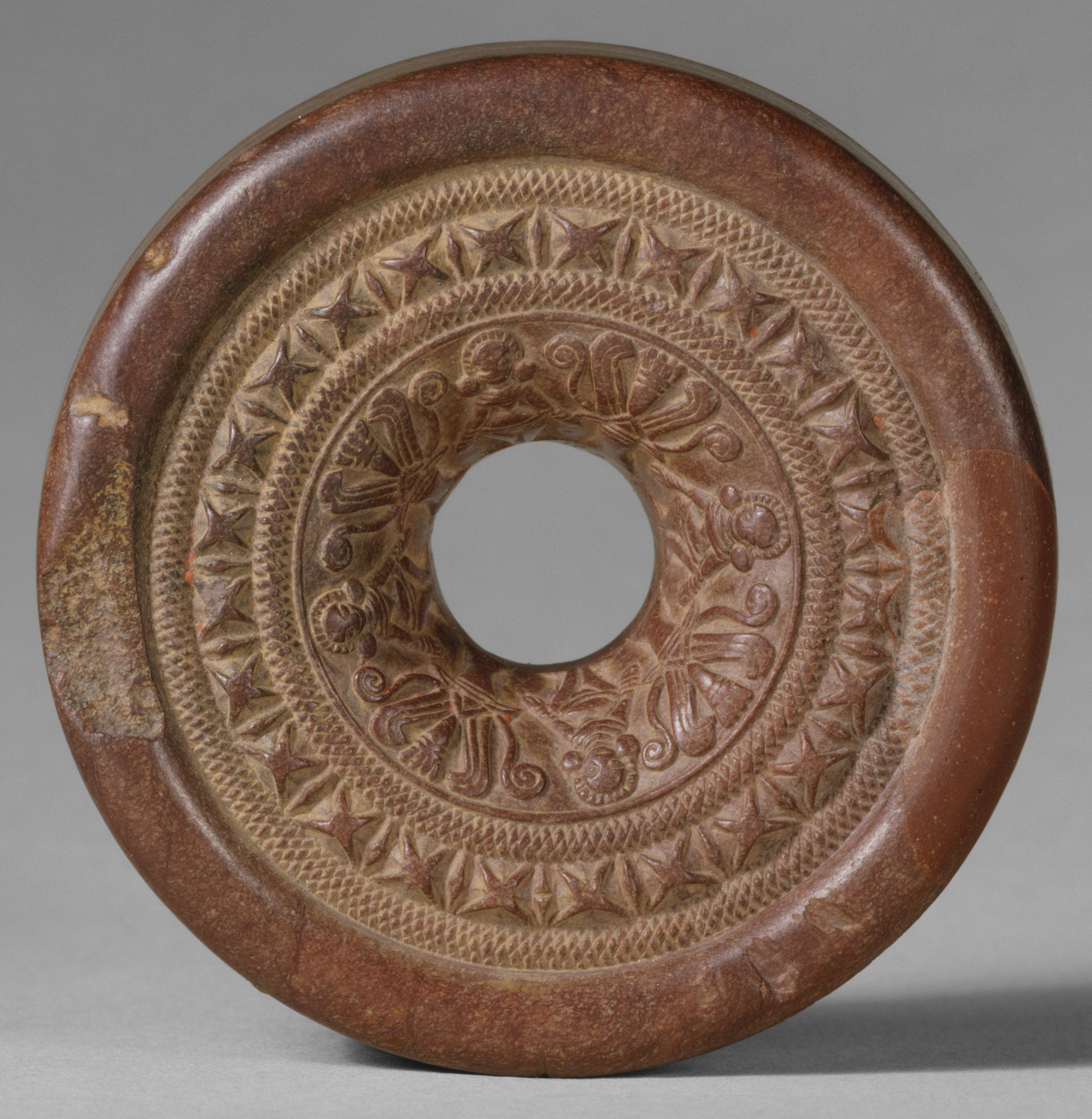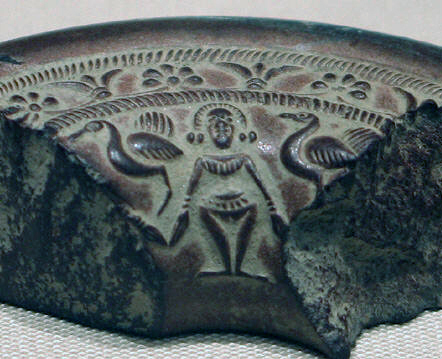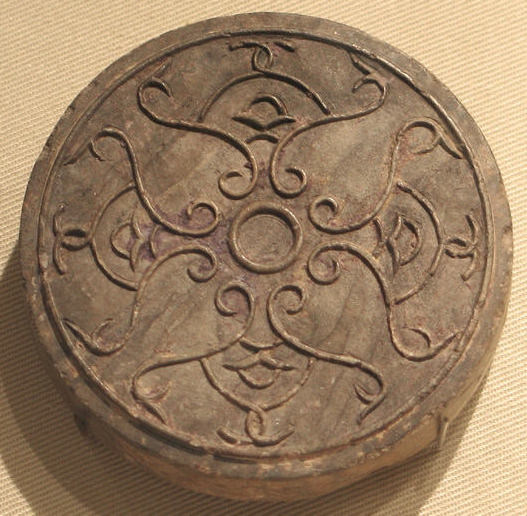Ringstone on:
[Wikipedia]
[Google]
[Amazon]

 The ringstone is a distinctive type of artefact and miniature sculpture made in India during the approximate period of the Mauryan Empire (c. 322–185 BCE) and the following Sunga Empire (187–78 BCE). They are usually dated to the third or second centuries BCE. They are shaped somewhat like a doughnut, but with straighter outer edges and they are flat and plain on the obverse. They are carved out of stone, with very fine
The ringstone is a distinctive type of artefact and miniature sculpture made in India during the approximate period of the Mauryan Empire (c. 322–185 BCE) and the following Sunga Empire (187–78 BCE). They are usually dated to the third or second centuries BCE. They are shaped somewhat like a doughnut, but with straighter outer edges and they are flat and plain on the obverse. They are carved out of stone, with very fine
File:Clevelandart 1977.36 (cropped).jpg, Complete example in the

"Unidentified Artist, Northeast Indian (Sunga Dynasty)"
David Owsley Museum of Art Collection, Ball State University (Ivory ring) *Bennett, Anna (2017)
"Sunga ringstone found in Thailand"photos of lecture slides
*Bennett, Anna (2019), "Suvarnabhumi, "Land of Gold"", in ''Suvarnabhumi, the Golden Land'', 2019, GISDA
PDF
*Lerner, Martin and Kossak, Steven, ''The Lotus Transcendent: Indian and Southeast Asian Art from the Samuel Eilenberg Collection'', 1991, Metropolitan Museum of Art (New York, N.Y.), , 9780870996139
google books
*Siudmak, John
Catalogue No. 5, "Indian and Himalayan Sculpture"
2016, Catalogue No. 2, *"V&A"
"Ring stone"
in collection

 The ringstone is a distinctive type of artefact and miniature sculpture made in India during the approximate period of the Mauryan Empire (c. 322–185 BCE) and the following Sunga Empire (187–78 BCE). They are usually dated to the third or second centuries BCE. They are shaped somewhat like a doughnut, but with straighter outer edges and they are flat and plain on the obverse. They are carved out of stone, with very fine
The ringstone is a distinctive type of artefact and miniature sculpture made in India during the approximate period of the Mauryan Empire (c. 322–185 BCE) and the following Sunga Empire (187–78 BCE). They are usually dated to the third or second centuries BCE. They are shaped somewhat like a doughnut, but with straighter outer edges and they are flat and plain on the obverse. They are carved out of stone, with very fine relief
Relief is a sculptural method in which the sculpted pieces are bonded to a solid background of the same material. The term '' relief'' is from the Latin verb ''relevo'', to raise. To create a sculpture in relief is to give the impression that th ...
on the top side that includes several zones of decoration surrounding a circular opening in the centre. Many feature a four-pointed star as a repeated border motif. They measure approximately across the diameter.
Their purpose, and any practical function, remains unclear and "enigmatic". They may have had a specific religious purpose or a more general one such as promoting fertility. They may have been used to make components of jewelry by pressing metal foil over the designs. Approximately 70 have been found, many only as fragments, with a 2014 find in Thailand
Thailand ( ), historically known as Siam () and officially the Kingdom of Thailand, is a country in Southeast Asia, located at the centre of the Indochinese Peninsula, spanning , with a population of almost 70 million. The country is b ...
being the first from outside the Indian subcontinent
The Indian subcontinent is a list of the physiographic regions of the world, physiographical region in United Nations geoscheme for Asia#Southern Asia, Southern Asia. It is situated on the Indian Plate, projecting southwards into the Indian O ...
; it is presumed this was imported from India.
Ringstones were first described by Alexander Cunningham, who published an image of one in the late nineteenth century. By the time of the S. P. Gupta survey of 1980, at least 32 ringstones and 36 discstones were recorded; the numbers have continued to rise.
Decoration
The designs vary, but all examples are finely carved, despite their small size. A number of components appear in a variety of arrangements. Typically the innermost zone, which runs down the sloping sides of the hole, has four standing female figures, many are nude "with fully exposed genitalia", bent knees pointing outward, and heels together, with jewelry and elaborate hairstyles, and trees separate them. Four-pointed stars are featured in motifs surrounding the rims of many of the stones. The women may be described as "goddesses", or "mother goddesses", and the trees, apparently of various species or apparently of palm species, may be described as thetree of life
The tree of life is a fundamental archetype in many of the world's mythological, religious, and philosophical traditions. It is closely related to the concept of the sacred tree.Giovino, Mariana (2007). ''The Assyrian Sacred Tree: A Hist ...
, but these interpretations are not universally accepted.
The example in the Cleveland Museum of Art
The Cleveland Museum of Art (CMA) is an art museum in Cleveland, Ohio, located in the Wade Park District, in the University Circle neighborhood on the city's east side. Internationally renowned for its substantial holdings of Asian and Egyptian ...
, where its three pairs of standing female figures with wide, full-length skirts are standing in the innermost section with their feet pointing toward the hole, it is followed by a cable or rope pattern border, then a border of fifteen animals in profile with their feet also toward the central hole. After another rope border there is one of "cross-and-reel" or a four-pointed star motif, then a final rope border before a plain and smooth outer zone. This ringstone is more elaborate than most examples, which are often similar, but without the animal zone. The example found in Thailand has an animal border but no "cross-and-reel" or star border, whereas those in the Victoria and Albert Museum
The Victoria and Albert Museum (often abbreviated as the V&A) in London is the world's largest museum of applied arts, decorative arts and design, housing a permanent collection of over 2.27 million objects. It was founded in 1852 and nam ...
and British Museum
The British Museum is a public museum dedicated to human history, art and culture located in the Bloomsbury area of London. Its permanent collection of eight million works is among the largest and most comprehensive in existence. It docum ...
each have two of those, but no animals. In one example the animals in a border are "lizards or crocodiles".
A somewhat similar ivory disc with a central hole only has the standing figures of women in its single zone. It is dated to the second century BCE.
Cleveland Museum of Art
The Cleveland Museum of Art (CMA) is an art museum in Cleveland, Ohio, located in the Wade Park District, in the University Circle neighborhood on the city's east side. Internationally renowned for its substantial holdings of Asian and Egyptian ...
(detailed description above)
File:MauryanRingstone.JPG, "Goddesses", plants, and four-pointed star motif border British Museum
The British Museum is a public museum dedicated to human history, art and culture located in the Bloomsbury area of London. Its permanent collection of eight million works is among the largest and most comprehensive in existence. It docum ...
File:MET 264860.jpg, Metropolitan Museum of Art, New York, with "Goddesses and Palm Trees" and four-pointed star motif
Purpose
Various purposes and uses for ringstones have been proposed, but without any theories gaining general acceptance. One suggestion is that they were matrices for moulding as jewelry created by beating thin sheets of metal, probably gold foil that always has been important in Indian culture, but evidence to support that theory has very few surviving examples from ancient times. Although not favored by some scholars, this theory may have gained some ground following the 2014 discovery in Thailand that was found near fragments of thin gold foil, one of which had an animal pattern very similar to that on the ringstone discovered at the same time.Ananda Coomaraswamy
Ananda Kentish Muthu Coomaraswamy ( ta, ஆனந்த குமாரசுவாமி, ''Ānanda Kentiś Muthū Kumāraswāmī''; si, ආනන්ද කුමාරස්වාමි ''Ānanda Kumārasvāmī''; 22 August 1877 − 9 Septem ...
has suggested that the ringstones might have been worn as jewelry, however, consensus exists among the other scholars that the ringstones are too heavy to have been worn. Others speculate that they may have been objects used in meditation, or somehow connected with fertility rituals. One scholar even suggested without explanation that they might have been used as a "physical contraceptive device".
Some examples have brief and informal inscriptions on the blank obverse. As of 2019, they had not been translated or interpreted.
Geographical distribution
Apart from the recent Thai find, the findspots are distributed (such as Mauryan territory) across north India, ranging from Taxila in the Punjab (now Pakistan) in the northwest toPatna
Patna (
), historically known as Pataliputra, is the capital and largest city of the state of Bihar in India. According to the United Nations, as of 2018, Patna had a population of 2.35 million, making it the 19th largest city in India. ...
, Bihar
Bihar (; ) is a state in eastern India. It is the 2nd largest state by population in 2019, 12th largest by area of , and 14th largest by GDP in 2021. Bihar borders Uttar Pradesh to its west, Nepal to the north, the northern part of West ...
in the east. Most have been found in urban centres on the Grand Trunk Road
The Grand Trunk Road (formerly known as Uttarapath, Sarak-e-Azam, Shah Rah-e-Azam, Badshahi Sarak, and Long Walk) is one of Asia's oldest and longest major roads. For at least 2,500 years it has linked Central Asia to the Indian subcontinent. ...
. As they are easily portable and have very consistent characteristics, they all may have been made in a single centre, for which Pataliputra
Pataliputra ( IAST: ), adjacent to modern-day Patna, was a city in ancient India, originally built by Magadha ruler Ajatashatru in 490 BCE as a small fort () near the Ganges river.. Udayin laid the foundation of the city of Pataliputra at the ...
(now Patna), the capital of the successive Mauryan and Sunga empires, is one obvious candidate.

Discstones
The ringstone tradition seems to have developed into the manufacture of the discstone, which is similar in shape, but having a flat top with a plain circular space in the center, rather than a hole that pierces the object. They also are manufactured in stone, but are not quite so precisely carved, with mostly plant-based decoration that is not divided into narrow circular zones in the same way, and they have abstract designs or symbols. The illustrated example (right) has relatively simple decoration, with narrow tendril-like elements. Discstones usually are dated to the first century BCE. In 2019, a contemporary report was published about a discstone found inMyanmar
Myanmar, ; UK pronunciations: US pronunciations incl. . Note: Wikipedia's IPA conventions require indicating /r/ even in British English although only some British English speakers pronounce r at the end of syllables. As John Wells explai ...
.
Collections
The largest collection of ringstones is in thePatna Museum
Patna Museum is the state museum of the Indian state of Bihar. Started on 3 April 1917 during the British Raj to house the historical artefacts found in the vicinity of Patna, it is in the style of Mughal and Rajput architecture and is known ...
. Other large Indian museums also have examples. Several major museums outside India have examples, including the Metropolitan Museum of Art
The Metropolitan Museum of Art of New York City, colloquially "the Met", is the largest art museum in the Americas. Its permanent collection contains over two million works, divided among 17 curatorial departments. The main building at 1000 ...
in Manhattan (3), the Cleveland Museum of Art
The Cleveland Museum of Art (CMA) is an art museum in Cleveland, Ohio, located in the Wade Park District, in the University Circle neighborhood on the city's east side. Internationally renowned for its substantial holdings of Asian and Egyptian ...
, the British Museum
The British Museum is a public museum dedicated to human history, art and culture located in the Bloomsbury area of London. Its permanent collection of eight million works is among the largest and most comprehensive in existence. It docum ...
(2), the Berlin State Museums
The Berlin State Museums (german: Staatliche Museen zu Berlin) are a group of institutions in Berlin, Germany, comprising seventeen museums in five clusters, several research institutes, libraries, and supporting facilities. They are overseen ...
, and the Victoria and Albert Museum
The Victoria and Albert Museum (often abbreviated as the V&A) in London is the world's largest museum of applied arts, decorative arts and design, housing a permanent collection of over 2.27 million objects. It was founded in 1852 and nam ...
in London (holding the only example with a provenance, from Taxila), and Los Angeles County Museum of Art
The Los Angeles County Museum of Art (LACMA) is an art museum located on Wilshire Boulevard in the Miracle Mile vicinity of Los Angeles. LACMA is on Museum Row, adjacent to the La Brea Tar Pits (George C. Page Museum).
LACMA was founded in 19 ...
. A number are in private collections and at least three were up for sale on the art market in the 2010s.Bennett (2019), 101 (all with John Siudmak)
Notes
References
*"Ball""Unidentified Artist, Northeast Indian (Sunga Dynasty)"
David Owsley Museum of Art Collection, Ball State University (Ivory ring) *Bennett, Anna (2017)
"Sunga ringstone found in Thailand"
*Bennett, Anna (2019), "Suvarnabhumi, "Land of Gold"", in ''Suvarnabhumi, the Golden Land'', 2019, GISDA
*Lerner, Martin and Kossak, Steven, ''The Lotus Transcendent: Indian and Southeast Asian Art from the Samuel Eilenberg Collection'', 1991, Metropolitan Museum of Art (New York, N.Y.), , 9780870996139
google books
*Siudmak, John
Catalogue No. 5, "Indian and Himalayan Sculpture"
2016, Catalogue No. 2, *"V&A"
"Ring stone"
in collection
Further reading
* Gupta, S.P., ''The Roots of Indian Art: Detailed Study of the Formative Period of Indian Art & Architecture – 3rd & 2nd Century BC'', 1980 (includes a survey of all examples then known) *Irwin, J., "Late Mauryan or early Sunga ring-stones", ''Journal of the Royal Asiatic Society'', April 1951, pp. 1–3 {{commons category, Ringstones Mauryan art Shunga Empire Indian sculpture Hardstone carving